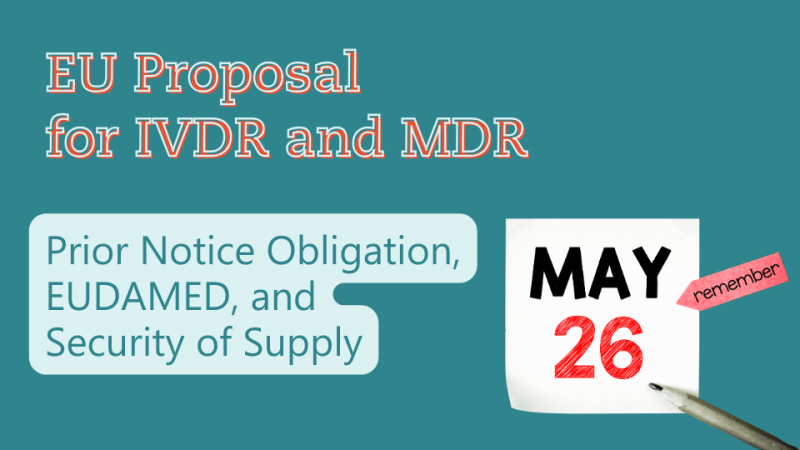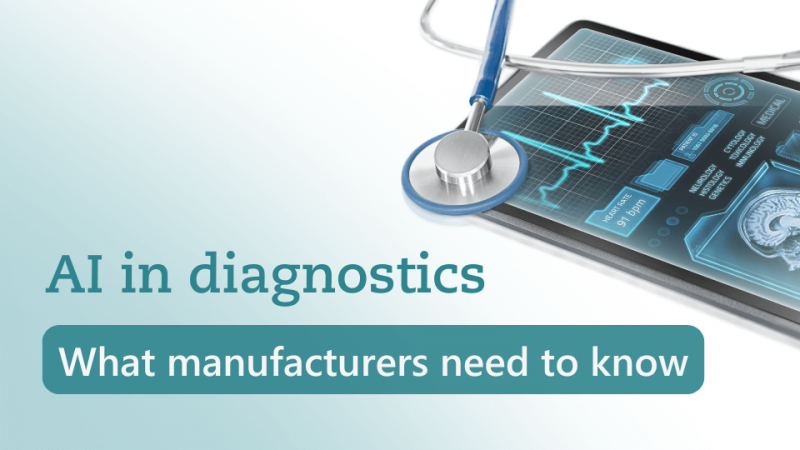EU Proposal for IVDR and MDR: Step-by-step implementation of Eudamed, prior notice obligation for supply interruptions, and transitional arrangements for certain in vitro diagnostic devices
26/03/2024
Do you have any questions about the article or would you like to find out more about our services? We look forward to hearing from you!Make a non-binding enquiry now
The implementation of the In Vitro Diagnostic Medical Device Regulation (EU) 2017/746 (IVDR) continues to be a significant challenge. Therefore, on January 23, 2024, the European Commission proposed a series of measures to lower the risk of shortages of medical devices and IVDs in the European Union.Editorial note, 9/30/2024: Regulation (EU) 2024/1860 was signed on June 13, 2024 and published in the Official Journal of the European Union on July 9, 2024.The EU Commission aims to address the following problem areas through the proposal:What changes with the EU Commission's proposal?
New prior notice obligation for manufacturers
At least six months before an expected supply interruption of medical devices, the manufacturer must inform the relevant competent authority of the expected interruption if it is reasonably foreseeable that this interruption could cause serious harm or the risk of serious harm to patients or public health. Additionally, economic operators, healthcare facilities, and healthcare professionals directly supplied with the product must also be informed.EUDAMED
The mandatory use of completed parts of EUDAMED is expected to commence by the end of 2025 and includes:Security of supply
To ensure the availability of in vitro diagnostics for patient care, the EU Commission now wants to grant manufacturers more time to transition to Regulation 2017/746 on in vitro diagnostic medical devices (IVDR) under certain conditions.
The extension of transitional periods applies to risk classes in which the involvement of a notified body is required:What needs to be done?
Implement the new prior notice obligation into your QMS. Until MDCG guidance is in place, arrangements should be made to assess an interruption of supply in terms of serious harm or risk of serious harm to patients or public health and ensure the transmission of relevant information.
If you have not yet implemented the requirements of the IVDR, conduct a gap analysis of your QMS and develop a plan for the necessary measures. It is expected that the IVDR requirements for the QMS will be assessed as part of ISO 13485 certification/re-certification. If you already meet the requirements of DIN EN ISO 13485:2021 (EN ISO 13485:2016/A11:2021), you should only need to adjust a few processes and interfaces.
The most significant challenge is the timely implementation of the conformity assessment procedures. Therefore, start planning the necessary steps for transitioning your IVDs to the IVDR now in order to submit your application for conformity assessment procedures within the specified deadlines.If you manufacture in-house products as a healthcare facility, review your documentation for completeness and address any gaps.The acceptance of the proposal is likely. We are available to assist you with all questions regarding the MDR, the IVDR, and the adaptation to them and look forward to hearing from you!Best regards,
Otmar Lienhart
- The vast majority of IVDs have not yet transitioned to the IVDR. By the end of October 2023, notified bodies had issued only 677 certificates for all risk classes (out of an estimated 15,000 certificates expected).
- Access to notified bodies remains an issue, especially for small and medium-sized enterprises, which account for 90% of IVD manufacturers.
- The average duration of the conformity assessment procedure, which includes the evaluation of the quality management system and technical documentation, is currently around 18 months.
What changes with the EU Commission's proposal?
New prior notice obligation for manufacturers
At least six months before an expected supply interruption of medical devices, the manufacturer must inform the relevant competent authority of the expected interruption if it is reasonably foreseeable that this interruption could cause serious harm or the risk of serious harm to patients or public health. Additionally, economic operators, healthcare facilities, and healthcare professionals directly supplied with the product must also be informed.EUDAMED
The mandatory use of completed parts of EUDAMED is expected to commence by the end of 2025 and includes:- Actors (voluntary use since December 2020),
- UDI/Devices (voluntary use since October 2021),
- Notified Bodies/Certificates (voluntary use since October 2021),
- Market Surveillance (expected completion in Q2/2024),
- Post-Market Surveillance and Vigilance (expected completion in Q2/2024).
Security of supply
To ensure the availability of in vitro diagnostics for patient care, the EU Commission now wants to grant manufacturers more time to transition to Regulation 2017/746 on in vitro diagnostic medical devices (IVDR) under certain conditions.The extension of transitional periods applies to risk classes in which the involvement of a notified body is required:
- December 31, 2027, for Class D devices;
- December 31, 2028, for Class C devices;
- December 31, 2029, for Class B products and Class sterile A devices.
- the devices do not present an unacceptable risk to the health or safety of patients, users, or other persons or to other aspects of public health protection.
Note: this falls within the responsibility and duties of the competent authorities (Articles 89 and 90 of the IVDR) and does not constitute an additional requirement for manufacturers; - the manufacturer has established a quality management system (QMS) by May 26, 2025, at the latest, in accordance with Article 10(8);
- by a certain date, the conformity assessment procedure between the manufacturer and a notified body must be agreed upon in writing (application for conformity assessment procedures by May 26, 2025 (Class D), May 26, 2026 (Class C), May 26, 2027 (Class B and sterile Class A products); a written agreement is reached within an additional 4 months).
What needs to be done?
Implement the new prior notice obligation into your QMS. Until MDCG guidance is in place, arrangements should be made to assess an interruption of supply in terms of serious harm or risk of serious harm to patients or public health and ensure the transmission of relevant information.If you have not yet implemented the requirements of the IVDR, conduct a gap analysis of your QMS and develop a plan for the necessary measures. It is expected that the IVDR requirements for the QMS will be assessed as part of ISO 13485 certification/re-certification. If you already meet the requirements of DIN EN ISO 13485:2021 (EN ISO 13485:2016/A11:2021), you should only need to adjust a few processes and interfaces.
The most significant challenge is the timely implementation of the conformity assessment procedures. Therefore, start planning the necessary steps for transitioning your IVDs to the IVDR now in order to submit your application for conformity assessment procedures within the specified deadlines.If you manufacture in-house products as a healthcare facility, review your documentation for completeness and address any gaps.The acceptance of the proposal is likely. We are available to assist you with all questions regarding the MDR, the IVDR, and the adaptation to them and look forward to hearing from you!Best regards,
Otmar Lienhart
Our blog posts are researched and created with the utmost care, but are only snapshots of the regulations, which are constantly changing. We do not guarantee that older content is still current or meaningful. If you are not sure whether the article you have read on this page still corresponds to the current state of regulation, please contact us: we will quickly place your topic in the current context.



